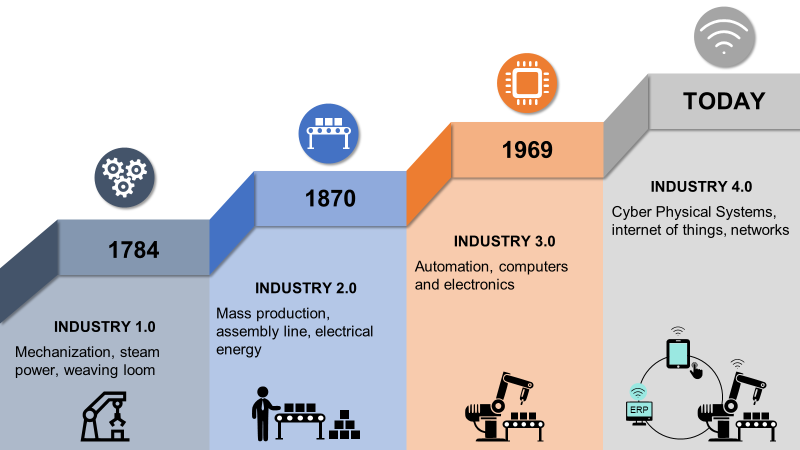Industry 4.0 is a Rocket—Don’t Let a Strategic Plan Designed for a Bicycle Leave You in the Dust

Any sufficiently advanced technology is indistinguishable from magic. Arthur C. Clark
Industry 4.0 is killing science fiction. With each new technological miracle, the window of time and imagination between fantasy inventions and real products and services grows smaller. Here are some examples:
- Doctors in the United Kingdom recently created an artificial cornea using human cells and a 3D printer.
- Dactyl, a robot, is capable of teaching itself how to manipulate objects with its fingers. The robot uses neural-network software to experiment randomly with movement. Each time the task is performed more accurately the neural connection grows stronger.
- ReWalk, a robotic exoskeleton, allows people with spinal cord injuries to walk again.

This fusion of the physical and digital worlds characterizes the new industrial revolution, or Industry 4.0. Industry has reinvented itself three times before; however, the current upheaval is different because the speed of innovation is constantly accelerating, bringing changes to the way we work, live and think that are highly disruptive.
Because associations sit at the intersection of people and professions, Industry 4.0 presents a unique opportunity to provide value to members by giving them tools to succeed in a business environment characterized by uncertainty.
Understand and Incorporate Trends
There’s just one catch. To achieve this goal, associations need to integrate the trends that drive industry 4.0 into their business models. This shift requires a new way of planning for the future.
At .orgSource we’ve done a lot of thinking about how organizations can make this transition. The primary challenge is a sacred cow that doesn’t produce much milk—a strategic planning process that can actually inhibit innovation and is out of step with the current pace of change.

To discover how we could offer a better solution, we convened a think tank composed of association leaders, who like us, love exploring controversial, complex and sometimes confounding problems. We also distributed a survey to understand how colleagues across the industry are approaching the planning process. What we learned from the survey wasn’t surprising. Most leaders are involved in planning. Their boards participate to varying degrees and everyone makes it a priority to keep the plan up-to-date. This sounds like a smooth journey toward implementation. But we also discovered that hidden fault lines, at junctures along the way, threaten to derail the process. You’re probably familiar with the roadblocks outlined in the image above.
Experiences in my consulting practice suggest that implementation is often doomed before plans are off the drawing board. The reason is simple. The wrong people set the objectives, and as a result, no one asks the right questions. Recently a client confided in me that every item on the organization’s plan included a technology component, and the staff did not have the IT experience to manage these projects. That’s a classic example of planning that took place in an information vacuum. This organization does not currently have the right structure or talent to achieve their goals.
Integrate Planning to Align With Industry 4.0
Strategy missteps pose a significant threat in the fast-moving, competitive Industry 4.0 marketplace. To deliver real value, and support members through professional disruptions, associations must incorporate the qualities that an Industry 4.0 environment demands for success. They must be:
- Addicted to analytics and savvy enough to use data to win love and loyalty
- Students of the marketplace who learn and can strategize based on the verdicts it returns
- Able to provide every member with the right information, in the appropriate format, on demand, 24/7
The .orgSource think tank concluded that an integrated approach to strategic planning is an effective way to align with Industry 4.0. Or, as we like to say, to become an Association 4.0, an organization that delivers value and relevance through changing times. Integrated planning stands traditional planning on its head. It removes the board from areas where they have limited expertise (administration/operations) and positions them to contribute in a more meaningful way (professional experience/knowledge).

In an integrated planning process, the board plays the central role of visionary. Instead of addressing the “how to,” they concern themselves with the bigger issue of “why.” They are charged with posing and answering significant questions like these:
- Why was our organization founded? What has changed over time?
- What is changing in our industry?
- What is the future that we want?
- What is the future that we want to avoid?
- What do we need to start asking ourselves now?
After these fundamental issues are identified and outlined, the staff, using their knowledge about available financial and human resources, sets the objectives that will realize the board’s vision.
Identifying business strategy falls to the executive leadership team. Then, directors and managers are responsible for operationalizing initiatives. The process cuts across the entire organization, and there is constant communication among staffers and departments to ensure collaboration. The CEO is the hub that turns the wheel. That leadership commitment makes the work an organizational priority. Assessing technology and financial requirements is a critical component, and the final step in an integrated process is the board’s approval of the budget.
For most organizations, removing the board from the tactical aspects of planning will require both a political and cultural reset. It may be necessary to take baby steps toward this goal. But leaders who make future success their highest priority will also have the passion, persistence and strength to embrace Association 4.0 and turn their organizations into rockets that shoot for the stars.

